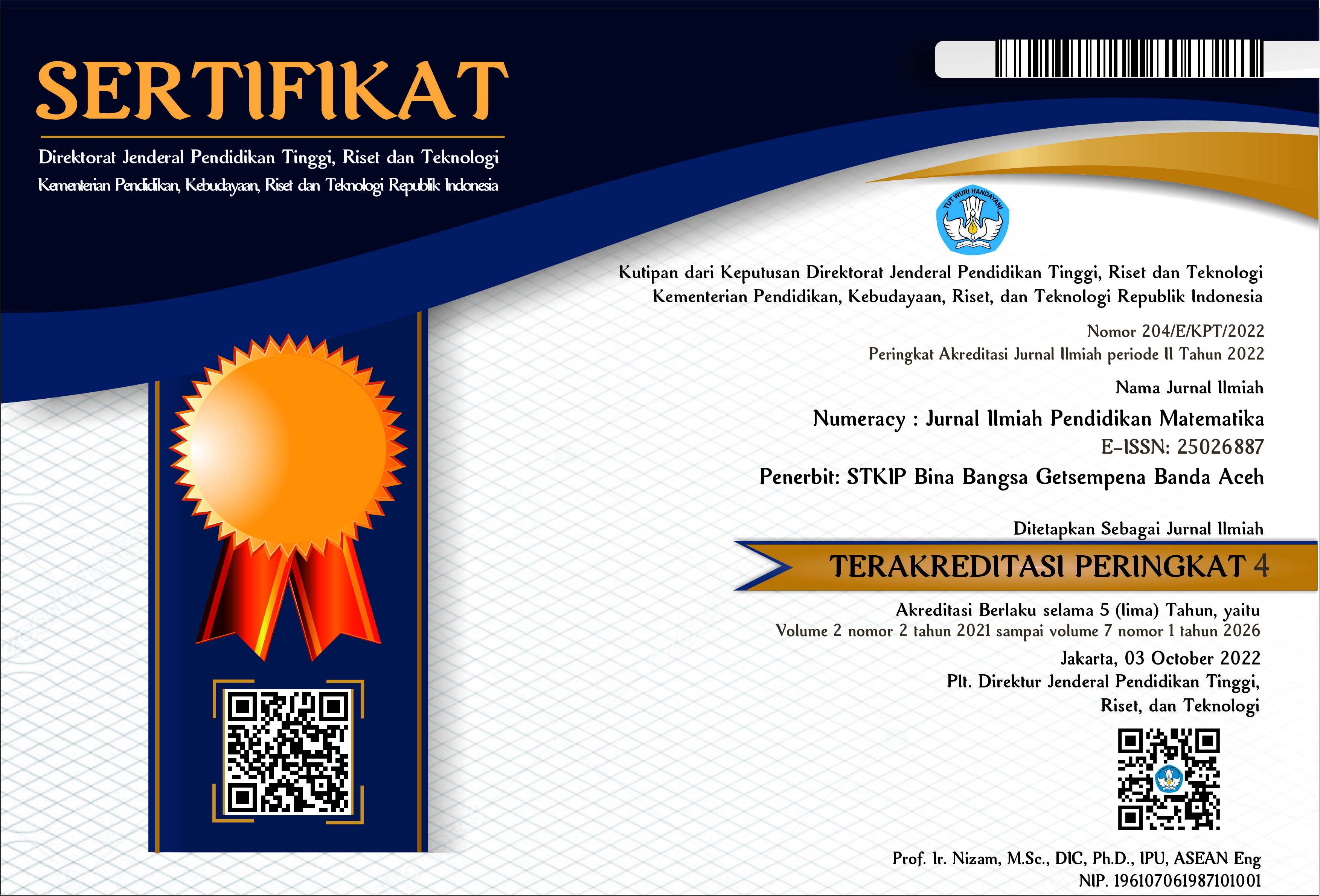MENINGKATKAN HASIL BELAJAR MATEMATIKA PADA MATERI BANGUN RUANG DENGAN MENGGUNAKAN APLIKASI GEOGEBRA DI SMP NEGERI 1 MILA
Abstract
The purpose of this research is to find out whether using Geogebra application can improve student learning outcomes material cube and beam in class VIII SMP Negeri 1 Mila. The population in this study were all students of SMP Negeri 1 Mila class VIII Academic Year 2017/2018 which consisted of five classes with 125 students. Sampling in this study uses purposive sampling technique. The sample in this study was class VIII-A and class VIII-C. Class VIII-A with 25 students as an experimental class and VIII-C class with 25 students as a control class. The control class is a class with the teaching and learning process without using the Geogebra application (teaching and learning process as usual), while the experimental class is a class with the teaching and learning process using the Geogebra Application. To obtain data in this study using research instruments in the form of test questions, consisting of essay item. The collected data is then analyzed using appropriate statistics. Because data that is normally distributed and homogeneous, t-test can be used to see student learning outcomes. The calculation results show that t-test = 2.41 and at the significance level α = 0.05, then from the distribution table t obtained = = 2,01 it appears that t counts not between . As a result the null hypothesis (H0) is rejected, it can be concluded that the increase in student learning outcomes in SMP Negeri 1 Mila is taught using the Geogebra Application in contrast to learning outcomes other than using the Geogebra Application.
Abstrak
Tujuan dalam penelitian ini adalah untuk mengetahui apakah dengan menggunakan aplikasi Geogebra dapat meningkatkan hasil belajar siswa pada materi kubus dan balok di kelas VIII SMP Negeri 1 Mila. Populasi dalam penelitian ini adalah seluruh siswa SMP Negeri 1 Mila kelas VIII Tahun Ajaran 2017/2018 yang terdiri dari lima kelas dengan jumlah 125 siswa. Pengambilan sampel dalam penelitian ini menggunakan teknik purposif sampling. Sampel dalam penelitian ini kelas VIII-A dan kelas VIII-C. Kelas VIII-A dengan jumlah siswa sebanyak 25 siswa sebagai kelas eksperimen dan kelas VIII-C dengan jumlah siswa sebanyak 25 siswa sebagai kelas kontrol. Kelas kontrol merupakan kelas dengan proses belajar mengajarnya tanpa menggunakan aplikasi Geogebra (proses belajar mengajarnya seperti biasa), sedangkan kelas ekeperimen merupakan kelas dengan proses belajar mengajarnya menggunakan Aplikasi Geogebra Untuk memperoleh data dalam penelitian ini menggunakan instrumen penelitian dalam bentuk soal tes, yang terdiri dari lima butir soal essay. Data yang telah terkumpul selanjutnya dianalisis dengan menggunakan statistik yang sesuai. Karena data merupakan data yang berdistribusi normal dan homogen, maka untuk melihat hasil belajar siswa dapat digunakan uji-t. Hasil perhitungan menunjukkan bahwa thitung = 2,41 dan pada taraf signifikasi α=0,05 maka dari tabel distribusi t didapat = = 2,01 terlihat bahwa t hitung tidak berada antara . Akibatnya hipotesis nihil (H0) di tolak, dapat disimpulkan bahwa peningkatan hasil belajar siswa di SMP Negeri 1 Mila yang diajarkan dengan menggunakan Aplikasi Geogebra berbeda dengan hasil belajar selain mengggunakan Aplikasi Geogebra.
Kata kunci: Hasil belajar, kubus dan balok, aplikasi geogebra
References
Arikunto, S. 2006. Prosedur Penelitian Suatu Pendekatan Praktik, Ed Revisi VI. Jakarta: Rineka Cipta.
Hohenwater, M. & Fuchs, K. 2004. Combination Of Dynamic Geometry, Algebra, and Calculus In The Software System Geogebra. [online]. Tersedia: www.geogebra.org/publications/pecs_2004.pdf.
Hohenwarter, M. 2008. Teaching annd Learning Calculus With Free Dynamic Magnetic Software Geogebra. [online]. Tersedia: http://www.publications.uni.lu/record/2718/files/ICME11-TSG16.pdf.
Hohenwater, M. 2010. The Strenght Of The Community: How Geogebra Can Inspire Technology Integration In Mathematics Teaching. Journal of MSOR Connections. Vol.9 No.2. May-July 2009
Sudjana, Nana. 2011. Penilaian Hasil dan Proses Belajar Mengajar. Bandung: Rosda Karya.



















